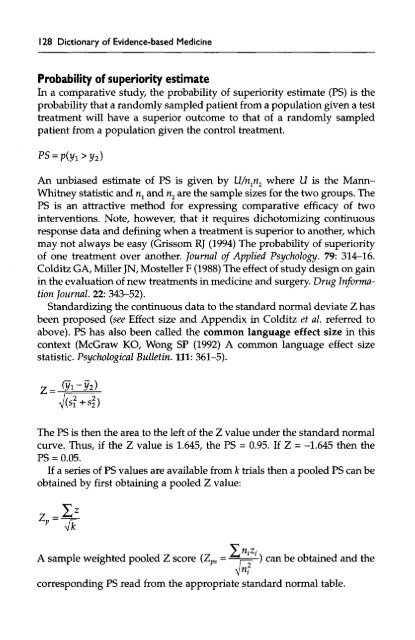Dictionary of Evidence-based Medicine.pdf
Dictionary of Evidence-based Medicine.pdf
Dictionary of Evidence-based Medicine.pdf
You also want an ePaper? Increase the reach of your titles
YUMPU automatically turns print PDFs into web optimized ePapers that Google loves.
128 <strong>Dictionary</strong> <strong>of</strong> <strong>Evidence</strong>-<strong>based</strong> <strong>Medicine</strong><br />
Probability <strong>of</strong> superiority estimate<br />
In a comparative study, the probability <strong>of</strong> superiority estimate (PS) is the<br />
probability that a randomly sampled patient from a population given a test<br />
treatment will have a superior outcome to that <strong>of</strong> a randomly sampled<br />
patient from a population given the control treatment.<br />
An unbiased estimate <strong>of</strong> PS is given by U/nji 2 where IT is the Mann-<br />
Whitney statistic and n^ and n 2 are the sample sizes for the two groups. The<br />
PS is an attractive method for expressing comparative efficacy <strong>of</strong> two<br />
interventions. Note, however, that it requires dichotomizing continuous<br />
response data and defining when a treatment is superior to another, which<br />
may not always be easy (Grissom RJ (1994) The probability <strong>of</strong> superiority<br />
<strong>of</strong> one treatment over another. Journal <strong>of</strong> Applied Psychology. 79: 314-16.<br />
Colditz GA, Miller JN, Mosteller F (1988) The effect <strong>of</strong> study design on gain<br />
in the evaluation <strong>of</strong> new treatments in medicine and surgery. Drug Information<br />
Journal 22: 343-52).<br />
Standardizing the continuous data to the standard normal deviate Z has<br />
been proposed (see Effect size and Appendix in Colditz et al. referred to<br />
above). PS has also been called the common language effect size in this<br />
context (McGraw KO, Wong SP (1992) A common language effect size<br />
statistic. Psychological Bulletin. Ill: 361-5).<br />
The PS is then the area to the left <strong>of</strong> the Z value under the standard normal<br />
curve. Thus, if the Z value is 1.645, the PS = 0.95. If Z = -1.645 then the<br />
PS = 0.05.<br />
If a series <strong>of</strong> PS values are available from k trials then a pooled PS can be<br />
obtained by first obtaining a pooled Z value:<br />
A sample weighted pooled Z score (Z ps = ~—-') can be obtained and the<br />
corresponding PS read from the appropriate standard normal table.










